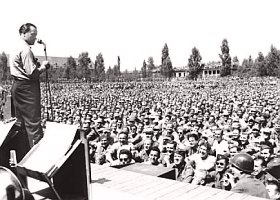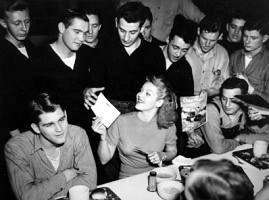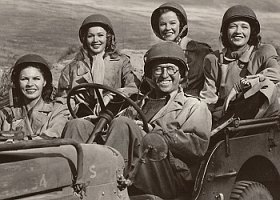    . .
.The
United Service Organizations (USO)
- Foundation -
. .
At the request of President Franklin D. Roosevelt,
an umbrella organization was created in New York on February 4, 1941, to
coordinate the efforts of six civilian volunteer agencies in order to provide
improved united homeland support on behalf of American service personnel.
These initial six civilian volunteer agencies were the Young Women’s Christian
Association (YWCA), the Young Men’s Christian Organization (YMCA), the
National Catholic Community Service (NCCS), the National Jewish Welfare
Board (NJWB), the Traveler’s Aid Association“ (NTAA) and the Salvation
Army.
.
.
The name of this newly founded private non-profit
charitable organization was the United Service Organizations for National
Defense (later shortened to United Service Organizations). The USO
was devoted to providing social and morale support to both male and female
members of the United States Armed Forces, primarily through programs offering
diverse entertainment and recreational opportunities during off-duty hours.
.
 The Service Women's Lounge
The Service Women's Lounge
of a Hawaii-based USO Club
|
........ |
American service personnel were stationed
at posts throughout the United States and in overseas locations spanning
the entire globe. For many of them, this was the first time they had traveled
so far from their homes, and they sought a comfortable non-military atmosphere
in which to relax. The USO met this need by providing a “Home Away from
Home.”
During the Second World War, the USO maintained
clubs in over three thousand locations, where over twelve million men and
women were given the chance to enjoy a vital and morale-boosting “Time
Out” from the war. |
.
| President Roosevelt was appointed as the first
USO honorary chairman, a position later transferred to each American president
in turn. From its inception, the USO was financed exclusively by
private citizen contributions donated generously by the American people. |
........ |

USO banner featuring President
Franklin D. Roosevelt
|
.
.
.
- USO Clubs und Canteens
-
.
 A typical USO Club in Austin,
Texas
A typical USO Club in Austin,
Texas
|
........ |
USO clubs and canteens were opened throughout
the world. Within the United States alone, the government made 300
buildings available for USO use.
Since normally available facilities were insufficient
to fill the need, many unusual places were utilized to accommodate USO
requirements. These included churches, cabin huts, museums, barns, yacht
clubs, old rental properties and even railway sleeping cars. |
.
| At the USO clubs, serviceman or servicewoman
could meet other people, converse and dance, watch movies, play party games,
follow sports or listen to music. While there, one also had the opportunity
to relax and simply rest, write letters home, read a book, obtain personal
assistance if necessary, or simply drink a cup of coffee or eat doughnuts.
Many USO clubs offered washing machines and
other laundry services, which enabled service personnel to properly clean,
iron and sort their clothes. The clubs additionally helped to search for
relatives and provided information about local and city tours from remote
bases. The USO maintained more than 3,000 clubs at its peak in 1944. |
........ |
 Cover of the February 1942
Cover of the February 1942
Saturday Evening Post
|
.

Members of a Mobile USO Canteen
pass out
doughnuts to American soldiers
|
...... |
There were also motorized USO units, which
offered soldiers a welcome mobile alternative to camp life in remote areas
where access was very difficult.
These “mobile USO canteens” provided soldiers
with meals and beverages. Some vehicles were also equipped with film projectors
and stocked with urgently needed supplies. |
.
| Not since the American Civil War had wartime
effort given such a feeling of national unity and solidarity within the
United States. This patriotic zeal awakened the desire in most civilians
to actively contribute to the welfare of their soldiers. On the home-front,
numerous young women volunteered to be USO hostesses within local communities.
At the USO clubs these ladies danced appreciatively with lonely soldiers,
played cards to cheer lonesome troops, and participated in table games
like Ping Pong to boost morale. They helped the soldiers to write letters,
mended clothes and sewed on buttons, and manned photo studios, workshops
and libraries. For example, the USO distributed over 13 million books
and 3 million magazines to American military personnel stationed throughout
the world. By the end of the war, more than one and half million Americans
had volunteered their spare time to work for the USO. |
.... |

USO Hostess Jacke Tucker was
elected
as National USO Queen of 1944
|
.
 Segregated USO Club
Segregated USO Club
for Black personnel in Nebraska
|
.... |
Although the public pronouncement of the USO
promised Welcome to all uniformed men and women without discrimination
on the basis of race, faith or skin color, segregation was a widespread
legal and social fact of life in wartime America. The military also
practiced racial segregation and much religious and social stigmatization
based on differences in wealth and class background. Labor unionist and
other suspected communist influences were especially frowned upon, and
there was fear in some towns that the USO effort might offer rallying points
for the “masses” of soldiers. |
.
The unfortunate American segregationist attitude,
which at the time was both officially and unofficially endorsed, mandated
the separate establishment of USO clubs for different minorities and even
religiously persecuted groups. This adverse racial atmosphere forced most
USO clubs to operate exclusively for either White or Black soldiers.
For example, USO clubs designed to host Black servicemen and servicewomen
were furnished accordingly. They were stocked with “suitable” games, “non-threatening”
books and “harmless” movies for “colored” people. Afro-American entertainers
were largely confined to playing before Black-only unit audiences.
.
.
.
- Stage Door Canteens -
.
| American show-business stars and performers
enthusiastically joined the ranks of the USO to make an important contribution
to the war effort. The first “Stage Door Canteen” opened on Times
Square in New York City where servicemen and servicewomen could meet, intermingle,
dance and share meals with film and show celebrities free of charge. This
success led to the opening of more Stage Door Canteens elsewhere throughout
the country. The popular Stage Door Canteens were sponsored by the American
Theater Wing organization. |
....... |
 |
.

Bette Davis serves soldiers
in the Hollywood Canteen
|
........ |
Actress Bette Davis and actor John Garfield
were instrumental in having the film industry of Hollywood, California,
open the Hollywood Canteen in 1942. Under Bette Davis’s guiding direction,
this particular USO club enjoyed spectacular popularity and became quite
famous. Numerous Hollywood giants and leaders freely donated their services
to the celebrated establishment. |
.
.
.
- USO Camp Shows -
.
The USO Camp Shows was incorporated on October
30, 1941, as a distinct entity to provide live entertainment programs for
the troops serving in both rear and forward areas. USO Camp Shows
Inc. was subordinated to and supported by the USO.
| Entertainers and artists skilled in a wide
range of variety performances (actors, singers, dancers, mimes, musicians,
jugglers and even painters who made GI sketches for them to send home)
volunteered for the shows.
They traveled throughout the United States
and toured forward bases throughout the world providing live entertainment
for USO Camp Shows in front of appreciative soldiering audiences. |
..... |
 Bob Hope at a 1945 performance
Bob Hope at a 1945 performance
in Fritzlar, Germany
|
.

Marlene Dietrich wearing her
USO uniform
|
........... |
Many well-known Hollywood film stars and musicians
participated actively in the USO Camp Shows. These included notables such
as Judy Garland, Bette Davis, Humphrey Bogart, Lauren Bacall, Frank Sinatra,
Marlene Dietrich, Ann Sheridan, the Marx Brothers, James Cagney, James
Stewart, Gary Cooper, Danny Kaye, Al Jolson, Fred Astaire, the Andrews
Sisters, Joe E. Brown, Lucille Ball, Glenn Miller, Martha Raye, Mickey
Rooney, Betty Hutton, Dinah Shore und Bob Hope, as well as many, many others. |
.
| USO entertainers were sent wherever American
troops were stationed –whether in the deserts of Egypt; the cold tundra
of Alaska; bomb-ravaged Belgium; isolated patrol bases like Bermuda; the
key ports of Brazil; the jungles of Burma; the frigid wasteland of western
Canada; front-line China; battlefield Germany; rocket-threatened England;
combatant France; frozen Greenland; tropical Guam; the Pacific bastion
of Hawaii; the crucial Atlantic island of Iceland; the Soviet-aid-corridors
of Iran and Iraq; wartime Italy; Atlantic shipping base of Labrador; war-scarred
Luxembourg and the Netherlands; the rain-forest supply point of New Caledonia;
the rugged battle terrain of the Philippines or lend-lease harbors in the
Soviet Union. |
..... |
 USO starlet signs autographs
USO starlet signs autographs
for sailors in Alaska
|
.
The entertainment artists who voluntarily
toured the USO clubs, military bases, field camps and hospitals were soon
given a cherished nickname by the troops, “Soldiers in Greasepaint” (Soldiers
wearing theatre makeup).
.

USO show aboard ship at Pearl
Harbor
(Honolulu) Hawaii in 1945
|
............ |

USO entertainer at the Fort
Crook Hospital
in Omaha, Nebraska
|
.
Just as the appearance of these USO entertainers
played a crucial role in maintaining soldier morale in all areas visited,
their tours also rendered lifelong individual impressions on the participants
themselves. The soldiers constituted an extremely grateful and inspirational
audience which the entertainers themselves rarely experienced in postwar
public performances, and thus boosted their performance levels. The
arduous and sometimes dangerous USO tours also bonded many entertainers
and directors together with shared experience into durable friendships
that reshaped Hollywood as a global movement after World War II.
.
 |
........ |
Kay Francis, Carole Landis,
Martha Ray und Mitzi Mayfair (above) began their USO tour in late 1942
and went to England, Bermuda, North Africa and Ireland. Their tour experiences
became the basis of the 1944 movie, “Four Jills in a Jeep.” |
..
| The USO entertainer was often exposed to the
same dangers as the soldiers. They were not safe in cases of enemy air
strikes or ground offensives, and many were sickened because of hardship
and lack of adequate medical safeguards or medicine in many areas.
Many USO entertainers died, fell ill, suffered
injury or were incapacitated during hazardous USO tours. Among other accidental
mishaps, a single 1943 plane crash near Lisbon, Portugal, claimed the life
of musical star Tamara Dreisen and badly injured the wondrous singer Jane
Froman. |
........ |
 Renowned singer Jane Froman
on a USO Tour
Renowned singer Jane Froman
on a USO Tour
|
.
Between 1941 and 1947 there were more than
428,000 USO Camp Show performances, which entertained more than 173 million
military men and women in uniform. The USO Camp Show routes were scaled
back in 1947 but regained popularity after 1951 because of the United Nations
war in Korea. The original USO Camp Show, Inc., was finally dissolved in
1957 when its vital entertainment task was directly assumed by the USO,
which continues its legacy for United States servicemen and servicewomen
though the present day.
.
(Many thanks to Shelby L. Stanton for English
translation and additions)
.
|



 .
.





















